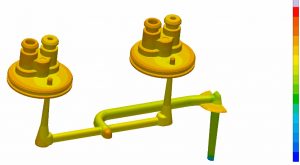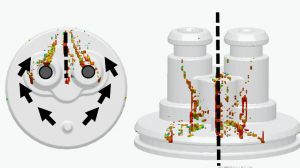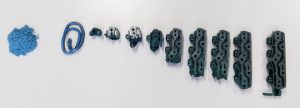From Tech Update Summer 2021
Try & error was yesterday, now even complex thermoset behaviour can be predicted
It’s the worst case scenario in a project: the start of production comes closer, the mold made of hardened steel is ready to go and during the sampling process failures appear on the product. The search for the root cause can require a lot of time and cost: why is the part breaking at a certain area, why are the cavities not filling completely or equally, … the list of questions can be long – and a nightmare for the project team.
With today’s technology it is however not necessary to go overcome these obstacles, by preventing them upfront !
For thermoplastic materials the mould flow simulation and finite element analysis are applied widely in the industry and helped to make huge steps forward in the designing and building of the injection tools and also to specify the ideal process parameters.
Thermosetting materials are a different world.
 We are not only facing a physical but also a chemical reaction, where the resin base reacts with the fillers and creates a three-dimensional network structure. For a long time this has been the big unknown variable in injection moulding.
We are not only facing a physical but also a chemical reaction, where the resin base reacts with the fillers and creates a three-dimensional network structure. For a long time this has been the big unknown variable in injection moulding.
Helvoet has now teamed up Sigmasoft, a leading supplier for simulation software for the plastic industry. In the cooperation we have trained our engineering team in Lommel / Belgium with the software and they have verified and analyzed the simulation results in our moulding laboratory, running different sampling trials based on the changing parameters.
What are the benefits of simulation the thermoset moulding process and what can be simulated?
For the moment we have added our most commonly processed materials to the database, reaching from different phenolics, over epoxy resins, polyurethanes over to BMC materials.
The list of benefits is quite extensive as the simulation helps before the mould is built, during the setting up of the process parameters and also afterwards in the analytics of possible failures. So what can we offer by using this simulation technology:
 Verification of part designs
Verification of part designs- Early stage feasibility studies
- Fast and cost-efficient A / B testing
- Comparison of material possibilities
- Evaluation of weld lines, temperature behaviour, filling and outgasing
- Determination of injection speed and reaction time
- Detection of weak spots
As summary we can say that it allows us to avoid loops in the development phase which saves money and shortens the time to market for a product, while after the development phase it can be used as troubleshooting tool to eliminate all possible failures and set up the most stable process.
